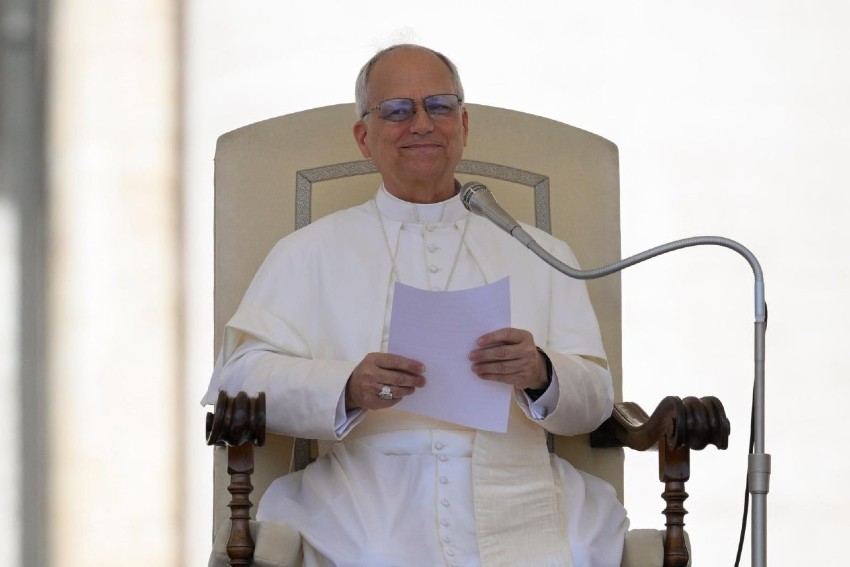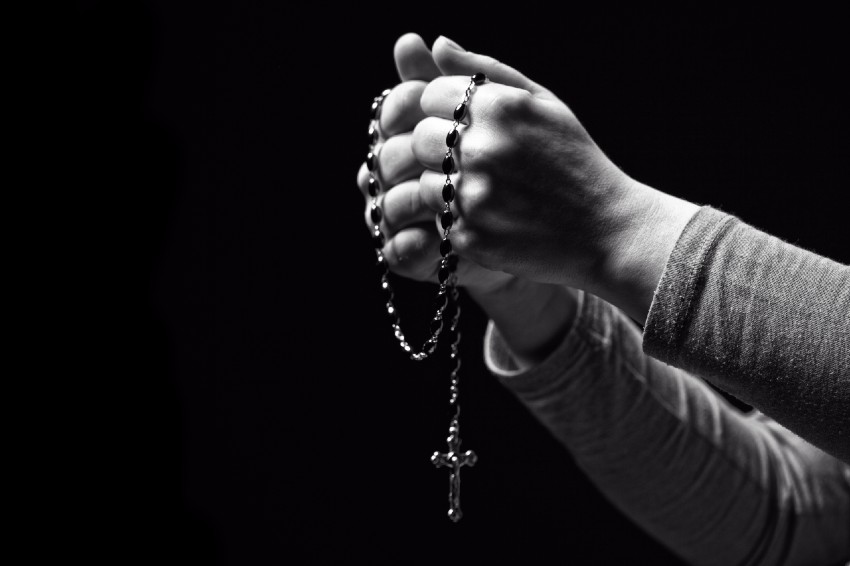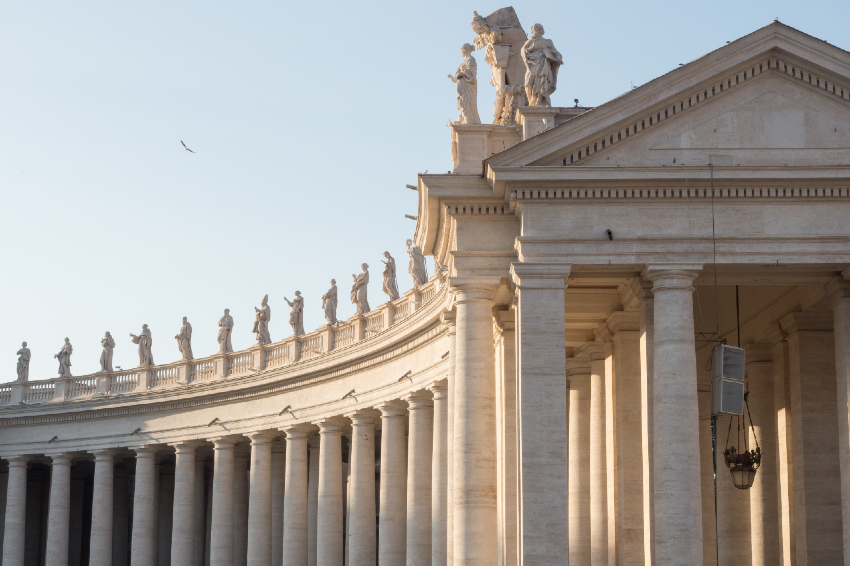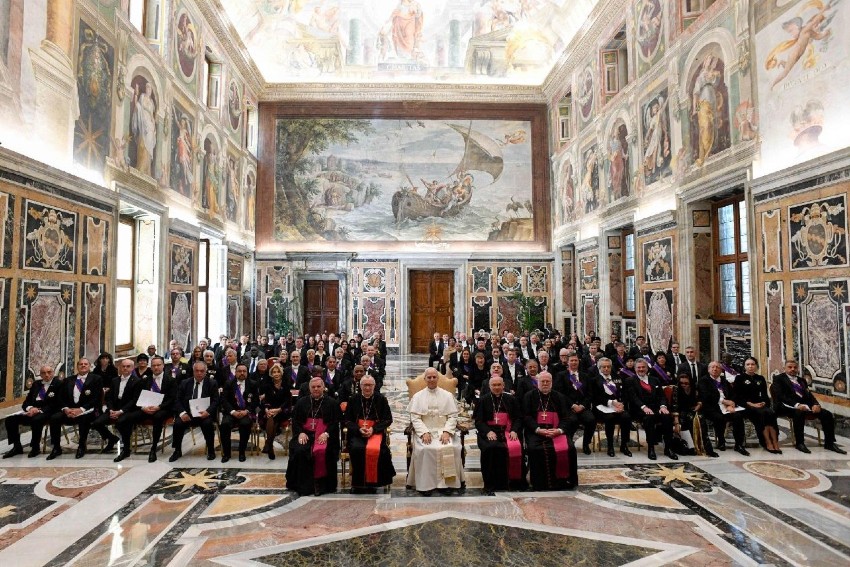
Pope Francis and Russian Orthodox Patriarch Kirill in Havana, Cuba in 2016. It was their first and only meeting…
Letter #29, 2025, Sunday, April 27: Orthodox Leaders on Pope Francis
Pope Francis‘s funeral Mass was celebrated yesterday in St. Peter’s Square.
I was present at the Mass, held under a blue sky and bright sun, in a Piazza San Pietro crowded with 200,000 faithful.
The body of Pope Francis was then transported across Rome to the Basilica of St. Mary Major, where the body of the Pope was laid to rest in a niche marked with one word only “Franciscus.”
United States President Donald Trump and his wife Melania attended the papal funeral Mass.
Just before the Mass, Trump met and sat in a chair near President Volodomyr Zelenskyy of Ukraine — a moment that is captured in the following video link.
The two men spoke together for several minutes. Trump and Zelelnsky both later said that there may be some announcement of movement toward peace in coming days.
Pope Francis while alive repeatedly called for peace in Ukraine, and an end to the war that has been raging there for more than three years now.
In the article below, American expert on Catholic-Orthodox affairs Peter Anserson, who writes a regular column in Inside the Vatican magazine, offers some reflections on the efforts of Pope Francis to “build bridges” to the world’s Orthodox Christians, including the Russian Orthodox.
—RM
P.S. To subscribe to Inside the Vatican, go here
As the world knows, Pope Francis died on “Bright Monday,” April 21, the day after the unusual event of Orthodox, Catholics, and Protestants celebrating Easter on the same day. He had survived his respiratory crisis, where he had come very close to death, and was able on Easter day to greet and bless thousands in St. Peter’s Square and to ride through the cheering crowds in his wheelchair on the back of a vehicle. You can see him in his last public appearance in a 7-minute video at (link). The Pope died suddenly on Monday morning from a cerebral stroke followed by cardiocirculatory failure. It is almost as if Our Lord had delayed the Pope’s death so that the Pope could experience this last very symbolic Easter.
The Pope’s funeral Mass will occur on Saturday, April 26, at 10 a.m. in St. Peter’s Square. In accordance with his Testament, he will not be buried in St. Peter’s Basilica, but rather in Rome’s Basilica of Santa Maria Maggiore. (link) In this regard, his Testament provides:
“I wish my final earthly journey to end precisely in this ancient Marian sanctuary, where I would always stop to pray at the beginning and end of every Apostolic Journey, confidently entrusting my intentions to the Immaculate Mother, and giving thanks for her gentle and maternal care. I ask that my tomb be prepared in the burial niche in the side aisle between the Pauline Chapel (Chapel of the Salus Populi Romani) and the Sforza Chapel of the Basilica, as shown in the attached plan. The tomb should be in the ground; simple, without particular ornamentation, bearing only the inscription: Franciscus.”
The Basilica was consecrated in the year 434, a few years after Mary was declared the Mother of God at the Council of Ephesus in 431, and has a close association with this great Council in Asia Minor. The nave and the arch in the Basilica are decorated with magnificent fifth-century mosaics of the Byzantine tradition. The most famous icon in the Basilica, Salus Populi Romani, before which Pope Francis always prayed before and after his trips, is said to have been brought from Crete in the year 590. It was in the Basilica that Pope Adrian II, in 867, solemnly blessed the liturgical books used by Saints Cyril and Methodius in their missionary work among the Slavic peoples. Thus, the final resting place of Pope Francis has a strong connection with the Christian East.
Letters or statements from primates of the various Orthodox or Oriental Orthodox Churches concerning the death of Pope Francis are already available on the Internet. The following are some examples:
Ecumenical Patriarch Bartholomew (link) “Throughout these twelve years of his Papacy, he stood as a faithful friend, a fellow pilgrim and supporter of the Ecumenical Patriarchate, a genuine friend of Orthodoxy, a true friend of the least of the Lord’s brethren, on whose behalf he often spoke, acted, and even washed their feet in an example of true humility and brotherly love.”
Patriarch John of Antioch (link) “The passing of Pope Francis is a loss for all humanity ….In this holy season of Pascha, divine providence has willed that Pope Francis return to the house of the Heavenly Father.”
Patriarch Theophilos of Jerusalem (link) “Pope Francis’ life was a luminous testament to the Gospel, a tireless witness to Christ’s boundless mercy, a steadfast champion for the poor, and a beacon of peace and reconciliation among all peoples….We entrust his noble soul to the infinite compassion of our Lord, and pray: ‘Well done, good and faithful servant; enter into the joy of your master.’ (Matthew 25:23).”
Patriarch Kirill of Russia (link) “For Christians worldwide, His Holiness’s commitment to standing in solidarity with the suffering and the marginalized held particular significance….May the All-Merciful Lord grant rest to the soul of His departed servant, who passed away on the second day of the celebration of Christ’s Resurrection by Christians worldwide, in the abode of the righteous.”
Patriarch Porfirije of Serbia (link) “I had the opportunity to meet the late Pope personally several times during his pontificate, so I feel obliged to testify today that he was a man who built peace and understanding between people and nations, with a special desire to develop cooperation with the Orthodox Churches.”
Archbishop Ieronymos of Greece (link) “He was a powerful personality, who spent himself for the prevalence of all that is good and of the values of the human being as God’s creature. Throughout his ministry as Bishop of Rome, every lowliest brother, the poor, the migrant, the refugees, in particular, occupied a central place in it.”
Pope Tawadros II of the Coptic Church (link) “The departure of this man, who served the entire world with genuine, heartfelt service to every person, is a great loss…. What brings comfort is that he left us a wonderful role model and example in the service of humanity everywhere.”
Patriarch and Catholicos Karekin II of the Armenian Apostolic Church (link) “The late Pope Francis of blessed memory was a humble, courageous, and kind shepherd who faithfully walked in the footsteps of our Lord Jesus Christ….He bore witness to the Gospel—consistently standing for justice and peace, offering special attention and care to those in need, and contributing significantly to strengthening interchurch relations.”
Improving relations with the Orthodox and the Oriental Orthodox Churches was a great priority for Pope Francis. He made a point of visiting early in his pontificate countries where Orthodoxy predominates or where primates of Orthodox or Oriental Orthodox Churches reside. This is shown by the following listing of these visits: 2014 – Israel (Jerusalem), Albania, Turkey. 2015 – Bosnia and Herzegovina. 2016 – Greece, Armenia, Poland, Georgia. 2017 – Egypt. 2019 – Bulgaria, North Macedonia, Romania. 2021 – Cyprus, Greece. In contrast, there were many predominantly Catholic countries that were never visited by Pope Francis such as Spain, Croatia, and Argentina. It appears that many primates and hierarchs, who personally met Pope Francis, were impressed by his humility and personal warmth. Kissing the panagia of an Orthodox bishop became a tradition for Pope Francis.
In considering the pontificate of Pope Francis with respect to improving relations with the Orthodox, there are two matters that are particularly important.
First, Pope Francis and Ecumenical Patriarch Bartholomew developed a closer personal friendship than has ever existed between the holders of these two extremely important offices — at least with respect to the last one thousand years. As just one indication of their friendship, Pope Francis always kept at the corner of his desk pad in his office a photograph of Ecumenical Patriarch Bartholomew.
One of the great hopes of Ecumenical Patriarch Bartholomew and Pope Francis was to celebrate together the 1700th anniversary of the Council of Nicaea to be held at Nicaea (Iznik), Turkey, apparently on May 24-25. (link) Hopefully, the new pope will now be there. The second important matter was the meeting between Patriarch Kirill and Pope Francis in Havana on February 12, 2016. It was the first meeting in history between a pope and a patriarch of Moscow.
Today, April 22, Patriarch Porfirije of Serbia and Patriarch Kirill of Moscow met with President Putin in Moscow. A video and transcript of the meeting can be seen at (link). In my opinion, it is an important transcript that should be read in its entirety (especially with respect to certain remarks by Patriarch Porfirije). One part of the discussion relates to Pope Francis. The following is a Google translation of this part of the transcript:
V. Putin: Your Holiness [Kirill], you mentioned what is happening to the west of us. We all know this well, we all saw it, we witnessed your meeting with the Pope of Rome, who left us during these Easter days. This, it seems to me, also shows that in the West there are still people, there are forces, and spiritual forces, who strive to restore relations and to revive spiritual principles.
Patriarch Kirill: Absolutely right.
V. Putin: Western culture – no matter what and who says – is based on Christian principles.
Patriarch Kirill: You very correctly recalled the late Pope. He was a man of fairly strong views and convictions, despite the fact that he was under great pressure – also in terms of cooling relations with the Russian Church. He is already in another world, so I can boldly, without asking his permission, quote him. When he was strongly pressed, forgive me for the rude word, he said only a short phrase: do not set me against Kirill. He turned and left. And those who influenced him were his close associates: that it was necessary to change course, that it was impossible – it was, so to speak, connected with Russian politics. This phrase – “do not set me against Kirill” [«не ссорьте меня с Кириллом»] – was always in my memory and consciousness while he was alive. Our relations were good. Now the Lord has called him to another world, but the memories of him are the kindest in terms of attitudes towards both Russia and the Russian Church.
V. Putin: I have the same. We met many times. It is quite obvious – I can say this – that he had a good attitude towards Russia. Considering his Latin American origin and the attitude among the overwhelming majority of citizens of Latin American countries, he probably felt this too and built relations with Russia in the most benevolent way.
Perhaps one of the greatest legacies of Pope Francis is that he was respected by people who are in “opposing camps” on certain important political (President Putin and western political leaders) or church (Ecumenical Patriarch Bartholomew and Patriarch Kirill) issues.
The following are two lists of the 135 elector-cardinals who are eligible to be elected the new pope (link) and (link).
A few of them are well-known to the Orthodox and have worked closely with the Orthodox, such as Cardinal Pizzaballa (Latin Patriarch of Jerusalem), Cardinal Koch (Prefect of the Dicastery for Promoting Christian Unity), and Cardinal Gugerotti (Prefect of the Dicastery for the Eastern Churches).
However, many of the names are not well-known to either Catholics or Orthodox. One hopes that the Holy Spirit will guide the cardinals in selecting a holy and wise pope who will bring greater unity within the Catholic Church and greater unity for Catholics, Orthodox, and Protestants.
Peter Anderson, Seattle, USA






Facebook Comments